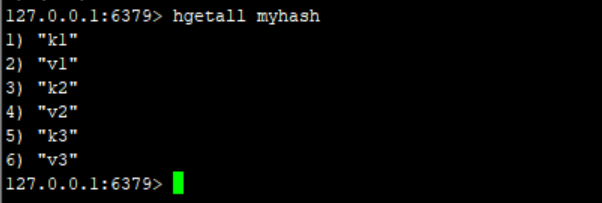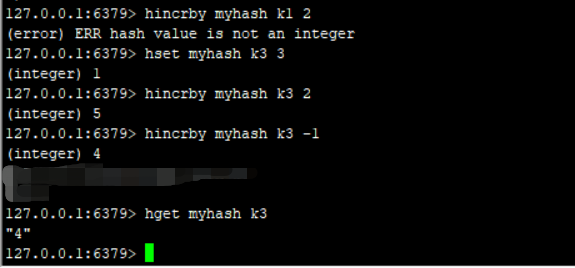Analysis of common operation examples of Hash, the basic data type of Redis
Redis data type Hash common operations
In Redis, the hash table is a data structure that maps string type fields and corresponding values. Particularly suitable for storing objects, each hash can store more than 4 billion key-value pairs.
Children's shoes who are familiar with python can think of it as a dictionary dict. The previous data type storage was k-v, and the hash storage is k-dict, and dict will have its own k-v.
1. hset
Assign values to the fields in the hash table. If the hash table does not exist, create a new hash table and perform the hset operation.
If the field already exists in the hash table, the old value will be overwritten.
1 |
|

2. hget
Returns the value of the specified field in the hash table. If the given field or key does not exist, nil is returned.
1 |
|

3. hmset
Set multiple field-value pairs into the hash table at the same time.
1 |
|
If the field already exists in the hash table, it will be overwritten.
If the hash table does not exist, an empty hash table will be created and the hset operation will be performed.

4. hmget
Returns the value of one or more given fields in the hash table.
1 |
|
If the specified field does not exist in the hash table, then a nil value is returned.

5. hgetall
Returns all fields and values in the hash table.
1 |
|
Note that in the return value, immediately following each field name (field name) is the value of the field (value), so the length of the return value is twice the size of the hash table.

6. hdel
Delete one or more specified fields in the hash table key. Non-existing fields will be ignored.
1 |
|
Returns the number of successfully deleted fields, excluding ignored fields.

7. hlen
Get the number of fields in the hash table.
1 |
|

8. hexists
Check whether the specified field of the hash table exists.
1 |
|
If the hash table contains the given field, return 1.
If the hash table does not contain the given field, or key does not exist, return 0.

9. hkeys
Get all fields in the hash table.
1 |
|
Contains a list of all fields in the hash table. When key does not exist, an empty list is returned.

10. hvals
Returns the values of all fields in the hash table.
1 |
|
Returns a list containing all field values in the hash table. When key does not exist, an empty table is returned.

11. hincrby
Adds the specified increment value to the field value in the hash table. This increment can also be a negative number, which is equivalent to Subtraction.
If the key of the hash table does not exist, create a new hash table and execute the hincrby command.
If the specified field does not exist, the value of the field will be initialized to 0 before executing the command.
If executed on a field that stores a string value, an error will be reported.

12. hsetnx
Assign values to fields that do not exist in the hash table.
If the hash table does not exist, create a new hash table and perform hset operation.
If the field already exists in the hash table, the operation is invalid.
If the key does not exist, create a new hash table and execute the hsetnx command.

Regarding the application of hash in redis, such as saving user information data and frequently changing information, if you do not want to use traditional k-v objects to store, you can use redis hash.
The above is the detailed content of Analysis of common operation examples of Hash, the basic data type of Redis. For more information, please follow other related articles on the PHP Chinese website!

Hot AI Tools

Undresser.AI Undress
AI-powered app for creating realistic nude photos

AI Clothes Remover
Online AI tool for removing clothes from photos.

Undress AI Tool
Undress images for free

Clothoff.io
AI clothes remover

Video Face Swap
Swap faces in any video effortlessly with our completely free AI face swap tool!

Hot Article

Hot Tools

Notepad++7.3.1
Easy-to-use and free code editor

SublimeText3 Chinese version
Chinese version, very easy to use

Zend Studio 13.0.1
Powerful PHP integrated development environment

Dreamweaver CS6
Visual web development tools

SublimeText3 Mac version
God-level code editing software (SublimeText3)

Hot Topics
 How to build the redis cluster mode
Apr 10, 2025 pm 10:15 PM
How to build the redis cluster mode
Apr 10, 2025 pm 10:15 PM
Redis cluster mode deploys Redis instances to multiple servers through sharding, improving scalability and availability. The construction steps are as follows: Create odd Redis instances with different ports; Create 3 sentinel instances, monitor Redis instances and failover; configure sentinel configuration files, add monitoring Redis instance information and failover settings; configure Redis instance configuration files, enable cluster mode and specify the cluster information file path; create nodes.conf file, containing information of each Redis instance; start the cluster, execute the create command to create a cluster and specify the number of replicas; log in to the cluster to execute the CLUSTER INFO command to verify the cluster status; make
 How to clear redis data
Apr 10, 2025 pm 10:06 PM
How to clear redis data
Apr 10, 2025 pm 10:06 PM
How to clear Redis data: Use the FLUSHALL command to clear all key values. Use the FLUSHDB command to clear the key value of the currently selected database. Use SELECT to switch databases, and then use FLUSHDB to clear multiple databases. Use the DEL command to delete a specific key. Use the redis-cli tool to clear the data.
 How to read redis queue
Apr 10, 2025 pm 10:12 PM
How to read redis queue
Apr 10, 2025 pm 10:12 PM
To read a queue from Redis, you need to get the queue name, read the elements using the LPOP command, and process the empty queue. The specific steps are as follows: Get the queue name: name it with the prefix of "queue:" such as "queue:my-queue". Use the LPOP command: Eject the element from the head of the queue and return its value, such as LPOP queue:my-queue. Processing empty queues: If the queue is empty, LPOP returns nil, and you can check whether the queue exists before reading the element.
 How to use the redis command
Apr 10, 2025 pm 08:45 PM
How to use the redis command
Apr 10, 2025 pm 08:45 PM
Using the Redis directive requires the following steps: Open the Redis client. Enter the command (verb key value). Provides the required parameters (varies from instruction to instruction). Press Enter to execute the command. Redis returns a response indicating the result of the operation (usually OK or -ERR).
 How to use redis lock
Apr 10, 2025 pm 08:39 PM
How to use redis lock
Apr 10, 2025 pm 08:39 PM
Using Redis to lock operations requires obtaining the lock through the SETNX command, and then using the EXPIRE command to set the expiration time. The specific steps are: (1) Use the SETNX command to try to set a key-value pair; (2) Use the EXPIRE command to set the expiration time for the lock; (3) Use the DEL command to delete the lock when the lock is no longer needed.
 How to read the source code of redis
Apr 10, 2025 pm 08:27 PM
How to read the source code of redis
Apr 10, 2025 pm 08:27 PM
The best way to understand Redis source code is to go step by step: get familiar with the basics of Redis. Select a specific module or function as the starting point. Start with the entry point of the module or function and view the code line by line. View the code through the function call chain. Be familiar with the underlying data structures used by Redis. Identify the algorithm used by Redis.
 How to use the redis command line
Apr 10, 2025 pm 10:18 PM
How to use the redis command line
Apr 10, 2025 pm 10:18 PM
Use the Redis command line tool (redis-cli) to manage and operate Redis through the following steps: Connect to the server, specify the address and port. Send commands to the server using the command name and parameters. Use the HELP command to view help information for a specific command. Use the QUIT command to exit the command line tool.
 How to configure Lua script execution time in centos redis
Apr 14, 2025 pm 02:12 PM
How to configure Lua script execution time in centos redis
Apr 14, 2025 pm 02:12 PM
On CentOS systems, you can limit the execution time of Lua scripts by modifying Redis configuration files or using Redis commands to prevent malicious scripts from consuming too much resources. Method 1: Modify the Redis configuration file and locate the Redis configuration file: The Redis configuration file is usually located in /etc/redis/redis.conf. Edit configuration file: Open the configuration file using a text editor (such as vi or nano): sudovi/etc/redis/redis.conf Set the Lua script execution time limit: Add or modify the following lines in the configuration file to set the maximum execution time of the Lua script (unit: milliseconds)






